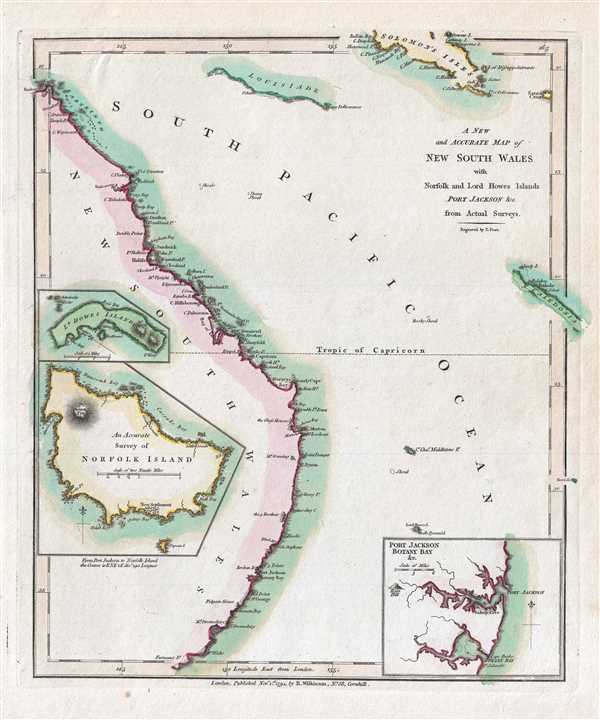This item has been sold, but you can get on the Waitlist to be notified if another example becomes available, or purchase a digital scan.
1794 Wilkinson Map of New South Wales, Australia
NewSouthWalesAustralia-wilkinson-1794
Title
1794 (dated) 11.5 x 9.5 in (29.21 x 24.13 cm) 1 : 12300000
Description
Another inset, in the lower left details Norfolk Island. This small Polynesian island, located roughly 290 British Leagues east of Australia, was proposed and developed by John Call as an auxiliary colony to the 1788 British settlement of New South Wales. Given its remoteness the Norfolk Island was, from the beginning, a penal settlement, its first colonists being Lieutenant Philip Gidley King and 15 convicts.
Just above the Norfolk Island inset, a third inset details Lord Howes Island. This small irregularly shaped island off the coast of New South Wales was discovered by the first wave of British colonists to enter the region in 1788. Although uninhabited until 1834, save for a large population of sea turtles, the Island’s discovery was big news back in London – a fact on which Wilkinson was quick to capitalize.
In general, this map offers good coastal detail, mostly gleaned from Cook’s excellent maps, as well as some notations on geographical features further inland, including the Mt. Dromedary, Pidgeon House, Rose Hill, The Three Brothers, Mt. Warning, The Glass Houses, and Mt. Upright. Engraved by Thomas Foot for the 1794 edition of Robert Wilkinson’s General Atlas. This is one of the earliest maps to detail the British colonization of New South Wales and was reissued with few changes in various atlases until about 1825.
CartographerS
Robert Wilkinson (fl. c. 1758 - 1825) was a London based map and atlas publisher active in the late 18th and early 19th centuries. Most of Wilkinson's maps were derived from the earlier work of John Bowles, one of the preeminent English map publishers of the 18th century. Wilkinson's acquired the Bowles map plate library following that cartographer's death in 1779. Wilkinson updated and retooled the Bowles plates over several years until, in 1794, he issued his first fully original atlas, The General Atlas of the World. This popular atlas was profitably reissued in numerous editions until about 1825 when Wilkinson died. In the course of his nearly 45 years in the map and print trade, Wilkinson issued also published numerous independently issued large format wall, case, and folding maps. Wilkinson's core cartographic corpus includes Bowen and Kitchin's Large English Atlas (1785), Speer's West Indies (1796), Atlas Classica (1797), and the General Atlas of the World (1794, 1802, and 1809), as well as independent issue maps of New Holland (1820), and North America ( 1823). Wilkinson's offices were based at no. 58 Cornhill, London form 1792 to 1816, following which he relocated to 125 Frenchurch Street, also in London, where he remained until 1823. Following his 1825 death, Wilkinson's business and map plates were acquired by William Darton, an innovative map publisher who reissued the General Atlas with his own imprint well into the 19th century. More by this mapmaker...
Thomas Foot (fl. 1790 - 1825) was a British map engraver active in London around the turn of the 18th century. Foot apprenticed to Garnet Terry of the Tinplate Workers. He was the son of William Foot, a stable keeper based on Chapel Street, Grosvenor Square, London. Foot engraved extensively for the Ordnance Survey from about 1801 to 1804, when he was imprisoned for debt. In addition to his work with the Ordnance Survey, Foot also engraved for Robert Wilkinson, William Faden, Aaron Arrowsmith, James Colnett, and many others. Learn More...

